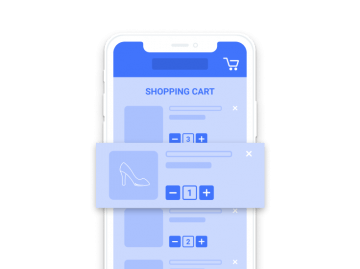There has been much talk of e-commerce in recent years. Meanwhile, it is m-commerce that is gaining ground, a trend which is connected with an increase in the popularity of shopping via mobile devices. Hence, business owners are faced with no easy dilemma: to invest in a native application devoted to product sales or to simply optimise their e-store for mobiles.
To answer, let us first have a look at research on newest market trends, advantages of supporting your own app and the procurement process as such.
When Customers Prefer Apps to Websites
Imagine, a customer goes into your store in search of a few items missing from their wardrobe. They find a t-shirt and trousers they like, unfortunately, the desired size is out of stock. They decide to check if they can order the items online. So, they take out their smartphone and search for the store’s name. They find no application, but they do stumble upon a neatly designed web page. They are a few clicks and a personal data questionnaire away from purchasing the item.
Each customer knows this procedure in and out. They have filled in such forms many a time – and would rather not do it again. They have installed apps for other shops, apps which store their data and allow instant purchases.
“Let’s see if Zalando has it”, runs through your customers’ mind and their instincts are right. They fire a simple, fast application and find what they were looking for. They do buy the desired items, just not from the store they had entered, but from the one that saved them the time and effort offering the simplest way to satisfy their shopping needs.
Mobile App: No Data, No Decision on Implementation
Many companies notice an increasing need to develop a mobile app of their own, but lack data on market research to be absolutely certain. Moreover, intensive work on current activities often takes priority over the next five year plan for the company. The sheer cost of developing an app seems to discourage rather then entice discussion with companies wondering when and if they will see a return on this investment.
A decision on whether or not to implement a mobile app should be an informed decision allowing for a few factors:
- What are the world’s leading trends and figures on online commerce?
- What tangible benefits does a native mobile app provide?
- How do you balance up the cost of app development?
M-Commerce as the Leading Trend in Online Commerce
Fewer and fewer online transactions are conducted using personal computers. According to a report by a consultancy Criteo, on the German market, which is thought akin to the Polish market, the year-on-year drop in online sales via desktops reached 13% in the first quarter of 2018, whereas the number of purchases using smartphones increased by 36% for the respective period. Even though buying via mobile websites is still popular, globally, the market share for shopping online with the use of applications increases; there was a 22% rise in shopping using apps recorded between 2017 and 2018.
Criteo reports that mobile sales account for 50% of all online transactions across most of the world, with applications being the dominant sales channel. This m-commerce trend is particularly noticeable in North America and Asia, where an overwhelming majority of customers prefer to shop by means of an application. Europe closes in on the trend, although mobile websites remain just as popular as apps here. Judging by the trend, it is only to be expected that in time native applications will outweigh mobile websites in Europe, too.
According to Statista, the value of mobile app generated income amounted to $88.3 billion in 2016. The amount is predicted to grow up to $188.9 billion in 2020.
Furthermore, people simply use mobile devices more and more. Noticeably, life seems to have gone mobile, and as a result our shopping habits have changed. Facebook, Instagram and other social media apps naturally occupy the lion’s share of the time people spend engaged with apps, however, solutions like deep linking help to instantly redirect customers from social media to a selected screen in an online retail application, which is a practice commonly employed by market leaders.
Does M-Commerce Pay Off?
For smartphone savvy customers the matter is simple: apps represent a quick and convenient solution as they allow access to a store’s offer directly from a phone’s home screen; also, they store transaction details and autocomplete forms; next, they collect information on shopping preferences such as size or style; last, they customise offers effectively.
Some companies launch applications unaccompanied by marketing, which results in little or no success on the market. A viable app promotional strategy, which helps achieve profits and gain competitive advantages, is essential.
Here are a few reasons why companies decide to invest in mobile apps:
- User convenience. Using mobile apps is no longer restricted to young users. On the contrary, in everyday life the trend may be noticed amongst users in their forties and fifties, too. We grow progressively accustomed to the convenience offered by smartphones. Customers are becoming increasingly aware that they need not click their way through lengthy websites, mobile or desktop alike, in order to buy a product; applications, which offer a variety of functions and greatly facilitate a purchase are by far more convenient than a mobile browser. Implementing apps caters to the needs of a market and the expectations of your customers, who are becoming more increasingly mobile. An app is just a few clicks closer to the customer. Nowadays, that makes a world of difference.
- Higher conversion rate for native apps. This statement refers to the fact that customers using an app to browse through products are more likely to make a purchase, than they would be when browsing by means of a website. According to a report by Criteo, conversion rate for an app is three times higher than that for a mobile site! What that translates to for retail businesses is a higher revenue and lower shopping cart abandonment rate, whereby customers add items to their cart but never complete the purchase. Moreover, in-app carts are saved until the next visit, and with proper use of push notifications business owners may actively encourage customers to return and close the transaction.
- Additional communication channel. Applications provide a continuous contact with your customers. You may send information on the latest special offers and new products, as well as suggest additional items which complement earlier purchases, e.g. a belt for trousers, a tripod for a new digital camera or a lotion cream set for a previously bought peel treatment. Coupons might be tailor-made and customers provided with such information become more loyal.
- Marketing costs reduced. This remark overlaps with the previous point. A customer base derived from an app helps you waste no time and effort on communicating through multiple channels. In a long term perspective, with direct and free access to a current customer base you can spend less on Google Ads or Facebook Ads.
- More data on the customer. Thanks to mobile apps you get to know your customers inside out. It is more than just browser standard cookie files, which store email address or personal data. It is information on shopping preferences, customer habits, transaction history and choices likely to be made by the customers in the future. With data profiled to such an extent at you disposal you can suggest products that your customers will find truly interesting. You will be able to shape marketing communication based not only on general data, but also enriched with specific preferences. This tangible and in-depth data analysis, which is obtained through applications, helps you run your business based on an equally tangible strategy, not just feeling your way.
- M-commerce as a significant element in omnichannel strategy. Nowadays, companies should ensure a coherent customer experience as customers feel like buying in a brick-and-mortar store one moment, only to switch to online shopping the next. The freedom to choose when and where to buy is key here; one moment customers would rather shop in a shopping centre on the weekends, then on their way to work, while browsing offers in a phone app only to choose a laptop or tablet in the quiet of their homes on other occasions. There can be no true omnichannel commerce without mobile sales.
M-Commerce App – Cost or Investment?
Last, let us deal with the issue that for many companies proves hard to comprehend, namely the cost of developing such an app. On average development costs alone vary between 100,000 PLN and 200,000 PLN, but you do need to budget for operating costs and marketing additionally. Is that a lot? If you judge in terms of money spent – yes, it seems a lot. However, there are factors at play here that better classify an app as an investment, rather than a spend, due to a return rate driven by higher conversion, lower abandonment rate, reduced marketing costs and greater customer reachability.
When planning to implement an application, prior to brainstorming ideas on how to set the company apart and amaze customers, a company should indicate its goals and measurable effects that an application is to help achieve, and only then define key metrics and methods of measurement. A mobile application is similar to a company start-up. It requires nurturing and continuous attention within the loop of build-measure-learn.
If you plan on verifying market information on mobile applications, do bear negative opinions in mind and investigate as to the causes of such feedback. Many companies have committed a lot of mistakes in the development and then management of their applications, which lead business owners to negatively evaluate apps as a sales channel. However, more and more companies admit their own responsibility for the past failures and make new, more conscious and effective attempts to grow their businesses via mobile channels.
When faced with global changes in customer habits we may no longer perceive applications solely as an attractive business accessory or a neat image booster. People seek apps, plain and simple. Customers expect companies to reach out to them by every means possible. In all honesty, the times when a company mobile app wowed customers and turned companies into market pioneers are long gone. Currently, a native shopping application is a standard solution, and many people would rather search Google Play or the App Store for a dedicated app then open browser and type in your company name onto the address bar. They may not find your company via a browser, what they will find are your competitors – one step closer to your customer.
You might also like

Increasing mobile app retention focuses on the users returning…

Most marketing and e-commerce experts agree that m-commerce applications…

The number of people shopping through mobile devices is…

There has been much talk of e-commerce in recent…

App Store Optimization, or ASO, entails the process of…



